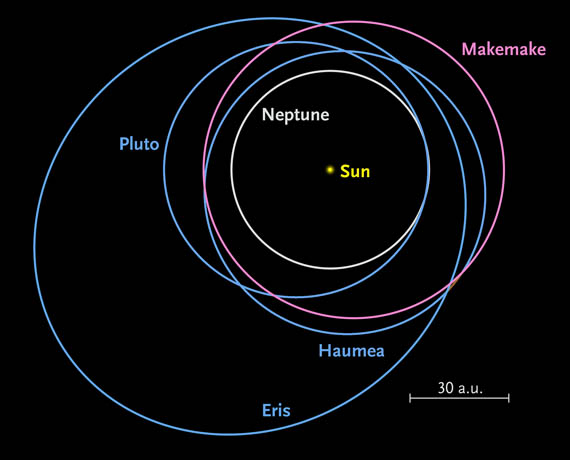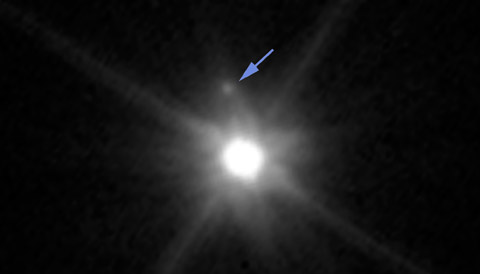A Moon for Kuiper Belt’s Makemake
Astronomers have been searching for companions to the distant dwarf planet Makemake for years. Finally, they've spotted one.

Orbits of the four known "dwarf planets" in the Kuiper Belt, compared to Neptune's.
Sky & Telescope diagram
Sky & Telescope diagram
Of the four "dwarf planets" now recognized in the outer solar system, Pluto, Eris, and Haumea all have at least one moon. The fourth, Makemake, seemed to be the odd dwarf out. Astronomers used the Hubble Space Telescope to search for any companions in 2006 but turned up nothing.
Now, having tried again, they've turned up "something." As announced jointly yesterday by the IAU's Minor Planet Center and Space Telescope Science Institute, images taken a year ago show an object traveling together with Makemake through the Kuiper Belt some 52.4 astronomical units (7.8 billion kilometers) from the Sun. It's magnitude 24.8 — 1,300 times fainter than Makemake itself. And that's about all that Alex Parker (Southwest Research Institute) and his three co-discoverers know for sure about this find, whose official designation is S/2015 (136472) 1 — but which they've nicknamed "MK2."

A Hubble Space Telescope image taken April 27, 2015, reveals the first moon (arrowed) ever discovered around the dwarf planet 136472 Makemake, which was discovered in 2005. The companion, nicknamed "MK2," is 0.6 arcsecond away from Makemake.
NASA / ESA / Alex Parker & others
NASA / ESA / Alex Parker & others
The problem is that the object shows clearly in images from April 27, 2015, but not in another set recorded just two days later. Parker's team concludes that MK2 is playing "hide and seek" with observers, hiding in the glare of Makemake at some times and popping into view at others. That's likely if we're seeing the moon's orbit nearly edge on and if it's not too distant from Makemake itself. For example, if its orbit is circular and 21,000 km in radius, MK2 should only be observable by HST about half the time; if the radius were 100,000 km, it should be in view 90% of the time. So, statistically, the tighter orbit seems more likely; it would have a period of about 12 days.
But it's all best-guesstimates for now. As the team points out in a write-up submitted to Astrophysical Journal Letters, the Hubble images really don't constrain the orbit well. It might have a semimajor axis anywhere up to 300,000 km (with a period of nearly two years) and an inclination anywhere from 63° to 87° — it could even be going in the opposite direction.
Those uncertainties aside, the moon's discovery appears to solve an observational puzzle that's nagged astronomers for years. "When the Spitzer and Herschel space observatories looked at Makemake, the thermal emission they saw was not consistent with one material," Parker tweeted yesterday. "Instead, it seemed like most of Makemake was very, very bright, but a small part of it must be dark and warmer." But even though this largish dwarf rotates in just 7.8 hours, the "dark stuff" never seemed to go away.
However, if MK2 has a diameter of 175 km (reasonable, since Makemake itself is 1,430 km across), then its surface must be very dark — just 4% reflective — and that would go a long way toward explaining the "dark, warm component" seen in Makemake's spectrum.

Here's how co-discoverer Alex Parker envisions the appearance of distant, icy Makemake and its recently discovered moon.
NASA / ESA / Alex Parker
NASA / ESA / Alex Parker
As was the case following the discovery of Charon around Pluto, the existence of MK2 has wide-ranging implications both for Makemake and large Kuiper Belt objects in general:
● Once they pin down the orbit, astronomers will quickly deduce the bulk density of Makemake. Right now estimates range from 1.4 g/cm3 (mostly ice) to 3.2 g/cm3 (mostly rock), even though frozen methane dominates its spectrum.
● If MK2 really is dark, how did it get that way? Perhaps it was captured, or perhaps it resulted from a long-ago collision that left it stripped of any volatile material.
● If MK2 really is in an edge-on orbit, then it might soon begin a series of "mutual events" with Makemake, with the two bodies periodically passing in front of and behind one another. When Pluto and Charon did this during the late 1980s, astronomers gleaned important new details about both bodies.
● If the plane of MK2's orbit is perpendicular to Makemake's spin axis, then the entire system must be significantly tipped with respect to the ecliptic. It also means that we're currently viewing Makemake near an equinox in its 309-year-long orbit around the Sun.
● And, finally, it means that all four of the Kuiper Belt's known dwarf planets possess at least one moon. This fact, in itself, might be a big deal. As Parker and his team conclude in their submitted paper, "The apparent ubiquity of trans-Neptunium dwarf-planet satellites further supports the idea that giant collisions are a near-universal fixture in the histories of these distant worlds."
Clearly, now we need another round of Hubble imagery. "No follow-up observations have yet been made or scheduled; we wait to see if the observations will be approved by the time allocation committee in the next few months," Parker says. "Observations could be scheduled as early as this summer, but more likely early next spring."
No comments:
Post a Comment